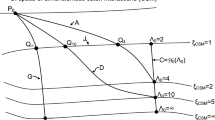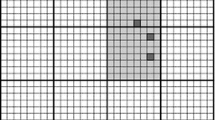Abstract
A cluster expansion renormalization group method in real space is-developed to determine the critical properties of the percolation model. In contrast to previous renormalization group approaches, this method considers the cluster size distribution (free energy) rather than the site or bond probability distribution (coupling constants) and satisfies the basic renormalization group requirement of free energy conservation. In the construction of the renormalization group transformation, new couplings are generated which alter the topological structure of the clusters and which must be introduced in the original system. Predicted values of the critical exponents appear to converge to presumed exact values as higher orders in the expansion are considered. The method can in principle be extended to different lattice structures, as well as to different dimensions of space.
Similar content being viewed by others
References
P. W. Anderson, Nobel Lecture,Rev. Mod. Phys. 50:191 (1978); N. F. Mott, Nobel Lecture,Rev. Mod. Phys. 50:203 (1978); I. A. Akhiezer and D. P. Belozorov,Phys. Rep. 204:253 (1991).
J. Fröhlich, inCritical Phenomena, Random Systems, Gauge Theories, K. Osterwalder and R. Stora, eds. (Elsevier, 1986), pp. 725–894; K. Binder and A. P. Young,Rev. Mod. Phys. 58:801 (1986); S. Kirkpatrick, inIll-Condensed Matter, R. Balian, eds. (North-Holland, 1979).
S. R. Broadbent and J. M. Hammersley,Proc. Camb. Philos. Soc. 53:629 (1956).
K. G. Wilson, Nobel Lecture,Rev. Mod. Phys. 55:583 (1983);Sci. Am. 241:140 (1979).
D. Stauffer,Phys. Rep. 54:1 (1979).
P. W. Kastelyn and C. M. Fortuin,J. Phys. Soc. Japan Suppl. 26:11(1969).
M. E. Fisher and J. W. Essam,J. Math. Phys. 2:609 (1961).
B. Payandeh,Nuovo Cimento 3:1 (1980).
A. B. Harris, T. C. Lubensky, W. K. Holcomb, and C. Dasgupta,Phys. Rev. Lett. 35:327 (1975); O. F. de Alcantara Bonfim, J. E. Kirkham, and A. J. McKane,J. Phys. A 13:L247 (1980);14:2391 (1981); and references therein.
C. Dasgupta,Phys. Rev. B 14:1221 (1976); T. W. Burkhardt and B. W. Southern,J. Phys. A 11:L253 (1978).
A. P. Young and R. B. Stinchcombe,J. Phys. C 8:L535 (1975).
S. Kirkpatrick,Phys. Rev. B 15:1533 (1976).
P. J. Reynolds, W. Klein, and H. E. Stanley,J. Phys. C 10:L167, (1977).
P. J. Reynolds, H. E. Stanley, and W. Klein,Phys. Rev. B 21:1223 (1980); Y. Yuge and C. Murase,J. Phys. A 11:L83 (1978).
G. Ord, B. Payandeh, and M. Robert,Phys. Rev. B. 37:467 (1988).
M. Knackstedt, J. McCrary, B. Payandeh, and M. Robert,J. Phys. A 21:4067 (1988).
C. Tsallis and G. Schwachheim,J. Phys. C 12:9 (1979).
H. Nakanishi and P. J. Reynolds,Phys. Lett. 71A:252 (1979).
B. Shapiro,J. Phys. C 12:3185 (1979).
M. E. Fisher, inCritical Phenomena, F. J. W. Hahne, eds. (Springer-Verlag, Berlin, 1982).
T. Niemeijer and J. M. J. van Leeuwen,Phys. Rev. Lett. 31:1411 (1973).
T. Niemeijer and J. M. J. van Leeuwen,Physica 71:17 (1974).
Author information
Authors and Affiliations
Additional information
This paper is dedicated to Prof. Philippe Choquard.
Rights and permissions
About this article
Cite this article
Payandeh, B., Robert, M. Real space renormalization group theory of the percolation model. J Stat Phys 76, 477–495 (1994). https://doi.org/10.1007/BF02188671
Received:
Accepted:
Issue Date:
DOI: https://doi.org/10.1007/BF02188671




